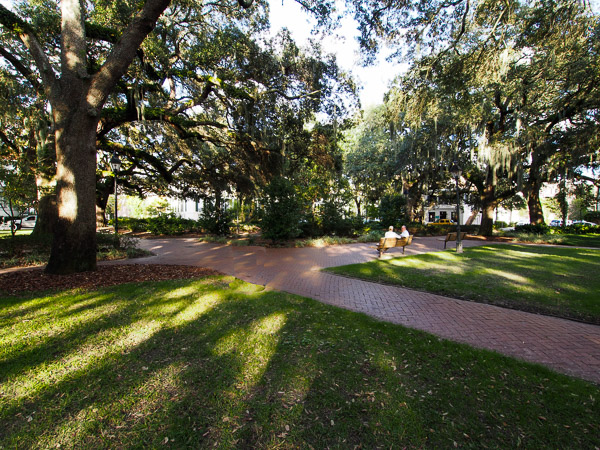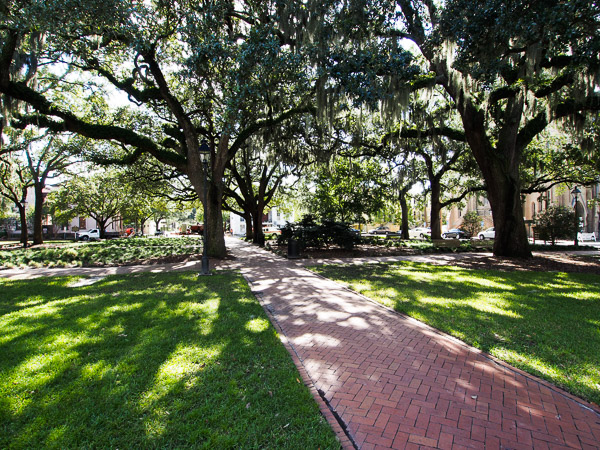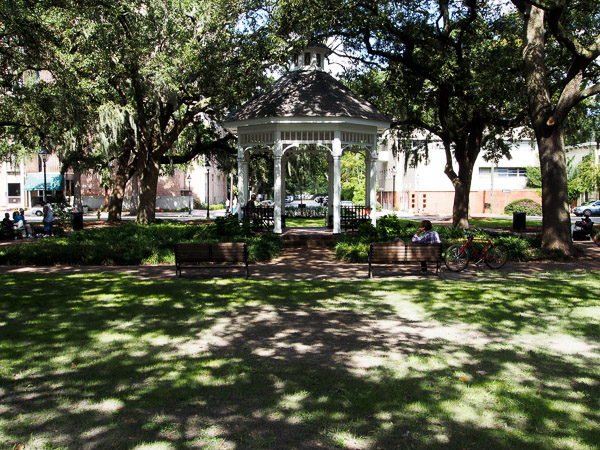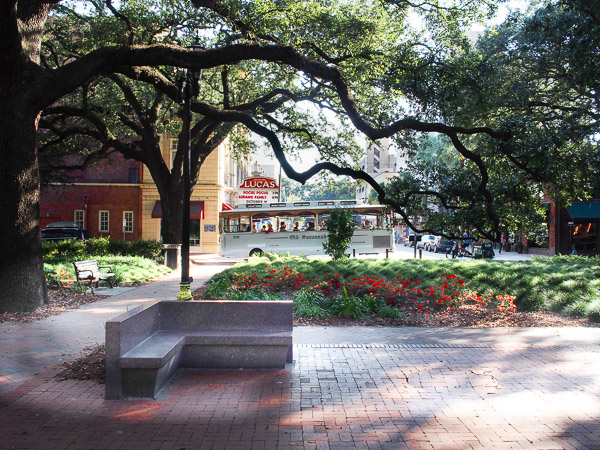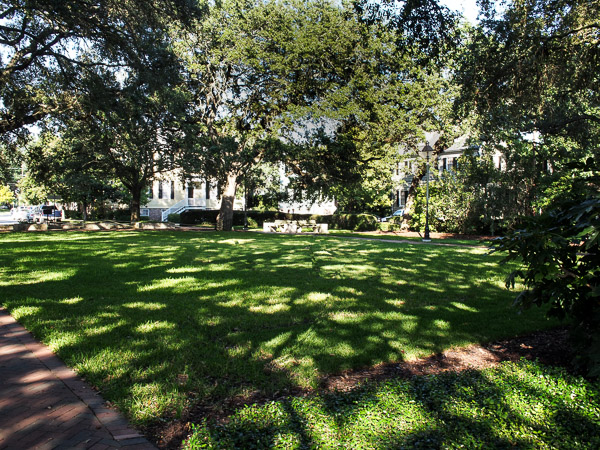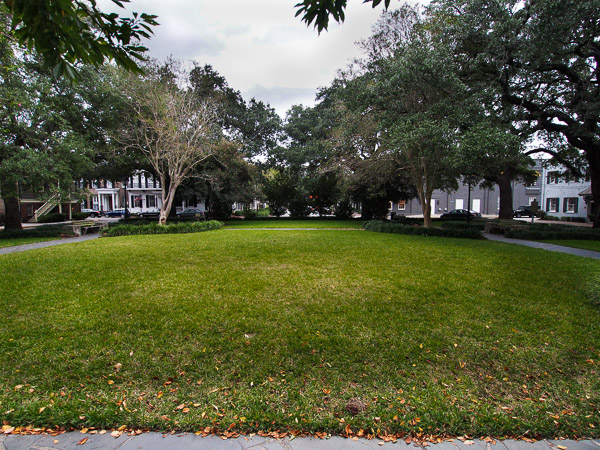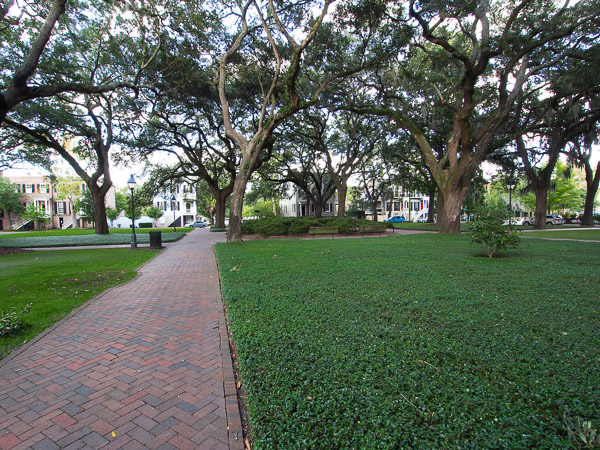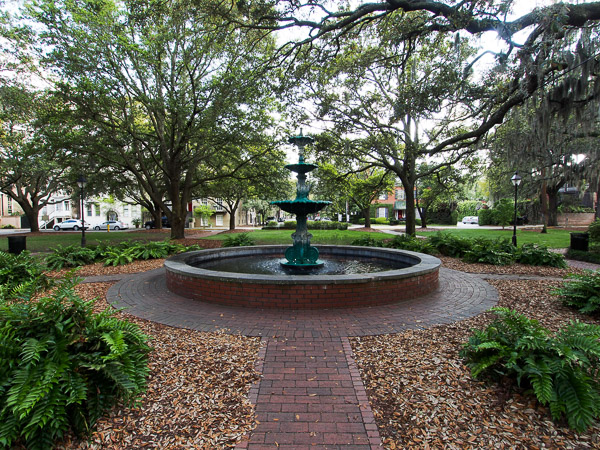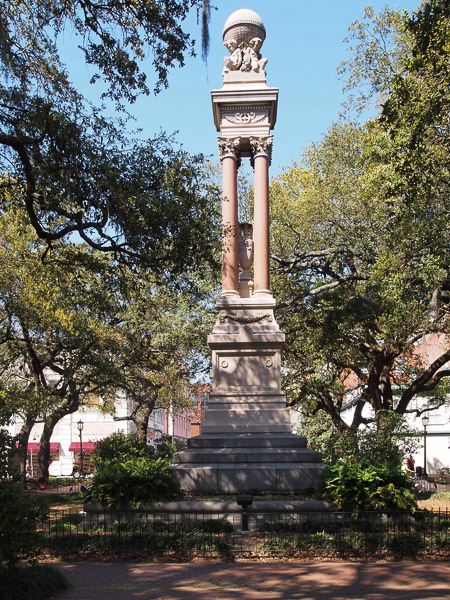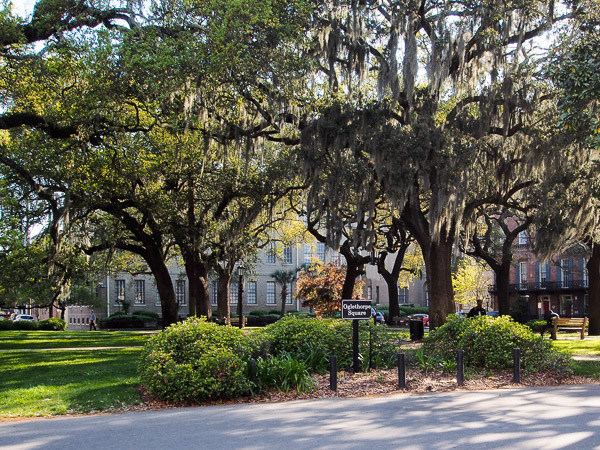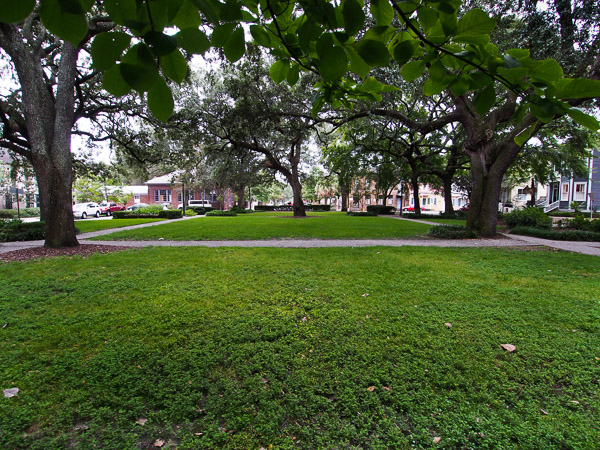Chatham Square to Whitefield Square
(4 Squares)
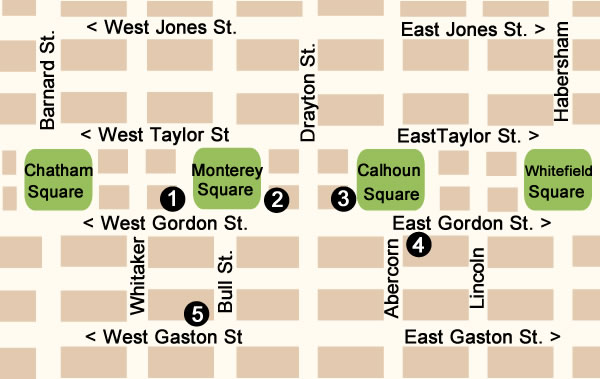
W. Taylor and E. Taylor Street (4 Squares):
Points of Interest:
Chatham Square
- Gordon Row - Series of 15 four story homes in a row
- Barnard Street School - 212 West Taylor Street
Monterey Square *****
 Mercer Williams House - Monday - Saturday 10:30a - 3:40p | Sun 12:30p - 4:00p
Mercer Williams House - Monday - Saturday 10:30a - 3:40p | Sun 12:30p - 4:00p
 Temple Mickve Israel - Monday - Friday, 10:00a -12:00p | 2:00p - 4:00p
Temple Mickve Israel - Monday - Friday, 10:00a -12:00p | 2:00p - 4:00p
Closed on Jewish and federal holidays.
The tour lasts thirty to forty-five minutes.
- Monument to Brigadier General Kazimierz Pulaski - Center of Monterey Square
Calhoun Square
 Wesley Monumental United Methodist Church
Wesley Monumental United Methodist Church
Tours Every Friday at 10:00a (Tour is 1 hour)
 Massie Hertiage Center - Hours: Monday - Saturday 10:00a - 4:00p | Sunday 12:00p - 4:00p
Massie Hertiage Center - Hours: Monday - Saturday 10:00a - 4:00p | Sunday 12:00p - 4:00p
Whitefield Square
- First Congregational Church - 421 Habersham Street
Chatham Square
Points of Interest
- Gordon Row - Series of 15 four story homes in a row
- Barnard Street School - 212 West Taylor Street
Chatham Square was laid out in 1847 and named in 1851 for William Pitt, 1st Earl of Chatham. Chatham Square was one of the last Squares to be built. The square is located on Barnard, between Taylor and Gordon Streets. Chatham Square is a beautiful and peaceful place to relax with the old oak trees giving the square a lot of shade especially on a hot summer day.
There are two buildings of interest at Chatham Square. The first is the Barnard Street School (now owned by SCAD). This historic structure, completed in 1901, is located at 212 West Taylor Street is known for its distinctive Italian tile roof. The Square was used as a playground for the students of the Barnard Street school. The other interest is a set of buildings called Gordon Row. It is a series of 15 four story homes in a row. Today they are used as rental properties.
Monterey Square *****
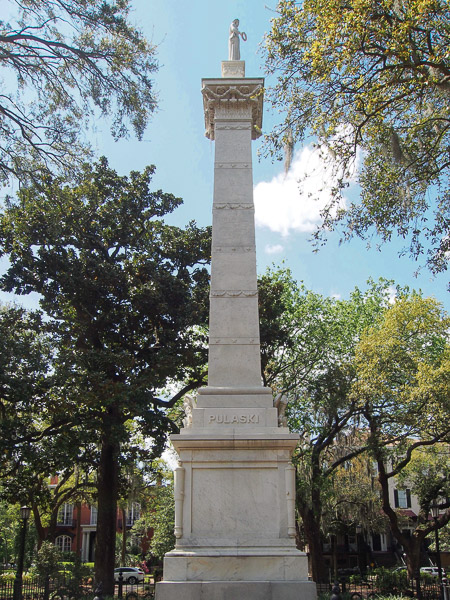
Monument to Brigadier General Kazimierz Pulaski
Points of Interest
 Mercer Williams House - Monday - Saturday: 10:30a - 3:40p | Sunday 12:30p - 4:00p
Mercer Williams House - Monday - Saturday: 10:30a - 3:40p | Sunday 12:30p - 4:00p
 Temple Mickve Israel - Monday - Friday: 10:00a - 4:00p (last tour is at 3:00p)
Temple Mickve Israel - Monday - Friday: 10:00a - 4:00p (last tour is at 3:00p)
Closed on Jewish and federal holidays.
The tour lasts thirty to forty-five minutes.
- Monument to Brigadier General Kazimierz Pulaski - Center of Monterey Square
Monterey Square was laid out in 1847 and was named to commemorate the capture of the city of Monterey, Mexico in 1846. In the center of the square is a monument built to honor General Casimir Pulaski, a Polish nobleman who came to Savannah seeking a better life and sacrificed his life in the Siege of Savannah in 1779.
Directly facing the Monterey Square is the Mercer-Williams house which was featured in the book " Midnight in the Garden of Good and Evil”. The Mercer-Williams House had begun being built around 1860 but was not completed until after the Civil War. The house was finally completed in 1871. It is located at 429 Bull Street.
This square also is home to Congregation Mickve Israel, which is one of the few Gothic-style synagogues in America, dating from 1878.
Monterey Square is located on Bull, between Taylor and Gordon Streets, and is widely considered to be the most picturesque of Savannah's squares. All of the surrounding buildings but one (the United Way Building) are original to the square.
Calhoun Square
Points of Interest
 Wesley Monumental United Methodist Church
Wesley Monumental United Methodist Church
Tours: Every Friday at 10:00a and last 1 hour.
 Massie Hertiage Center
Massie Hertiage Center
Hours: Monday - Saturday 10:00a - 4:00p | Sunday 12:00p - 4:00p
Calhoun Square was named for John C. Calhoun, known as “the Great Orator of the South. This square was laid out in 1851 along Abercorn Street. It is the only square with all of its original buildings intact. It is located on Abercorn, between Taylor and Gordon Streets.
Located on Gordon Street near Calhoun Square is the historic Massie Heritage Interpretation Museum. The school was built in 1856 with funds bequeathed by Peter Massie, to the city, which was used to educate underprivileged children.
Many beautiful homes in the Greek revival style were built around Calhoun square during the early 1800s. The elegant home at 426 Abercorn features a beautiful doorway, high stoop, marble steps and exterior details. Also, notice the wrought iron camellia on the south side of the house.
There are other beautiful homes, townhouses, row houses and the Wesley Monumental United Methodist Church, built in 1868, surrounding this square.
Whitefield Square
Points of Interest
- First Congregational Church - 421 Habersham Street
Whitefield Square was laid out in 1851 and was the final square built. It is named for the Rev. George Whitefield, founder of Bethesda Home for Boys in the 18th century which is still in existence on the south side of the city. Whitefield Square is located on Habersham, between Taylor and Gordon Streets.
Most of the houses around this square were built after the Civil War in the late Victorian or Queen Anne style. A beautiful gazebo stands in the center of the square, keeping with the Victorian “seaside” theme for the neighborhood.
A notable building facing the square is the First Congregational Church.
Forsyth Park
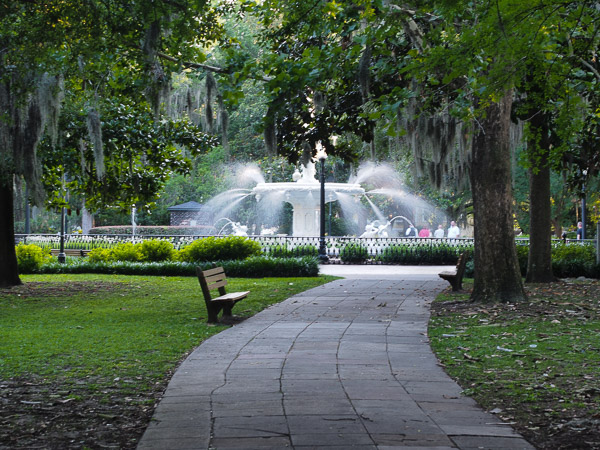 South end of Historic District at Bull Street and Gaston Street
South end of Historic District at Bull Street and Gaston Street
Points of Interest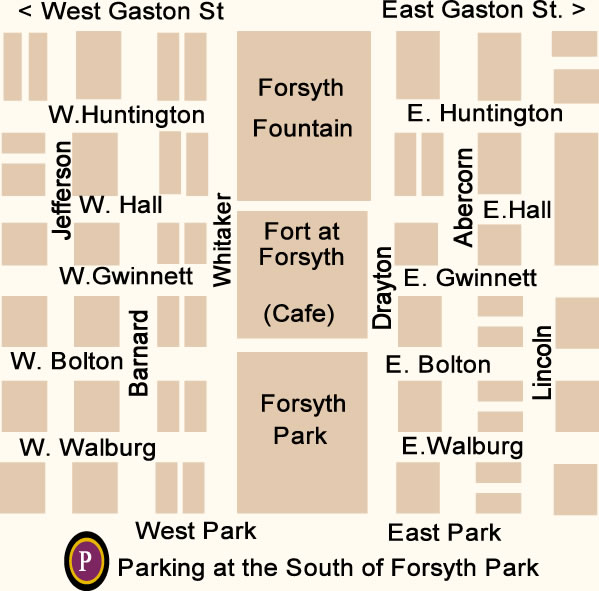
- Forsyth Park Fountain
- Confederate Monument - South of the Fountain
- Fragrant Garden - Located west of the Confederate Monument and adjacent to Whitaker Street behind a wrought-iron fence. Open 9:00a - 2:00p Mondays through Fridays
Forsyth Park is not one of the Squares -- but it is a must see on any tour of the Squares. It is at the very Southern end of the Historical District.
Forsyth Park is the largest park in the historic district of Savannah Georgia. It was originally created in the 1840s on 10 acres of land. In 1851, the park was expanded and named for Georgia Governor John Forsyth. Mr. Forsyth also donated 20 acres of his land to increase the park to occupy 30 acres in the historic district of Savannah. The park is bordered by Gaston Street on the North, Drayton Street on the East, Park Avenue on the South and Whitaker Street on the West. Forsyth Park is located at the southern edge of the Historic District.
Forsyth Fountain in Forsyth Park. The most popular feature of Forsyth Park is the large fountain that sits at the north end of Forsyth Park. The fountain was built and added to Forsyth Park in 1858. It resembles fountains in Paris and Peru. Every year on St. Patrick’s Day the city of Savannah dyes the water in the fountain green in celebration of Savannah's deep Irish heritage.
All around the Forsyth Park Fountain are benches. On any given day you can find many people, especially locals, lounging on the benches, relaxing, reading or taking in the scenery.
Forsyth Park is a hub of social interaction. There are people playing recreation sports, sun bathing, reading or just relaxing. On Saturdays there is a great farmer’s Market that takes place in Forsyth Park.
Today Forsyth Park features walking paths, open areas, beautiful tree cover, a fragrance garden and Savannah's magnificent Confederate Monument
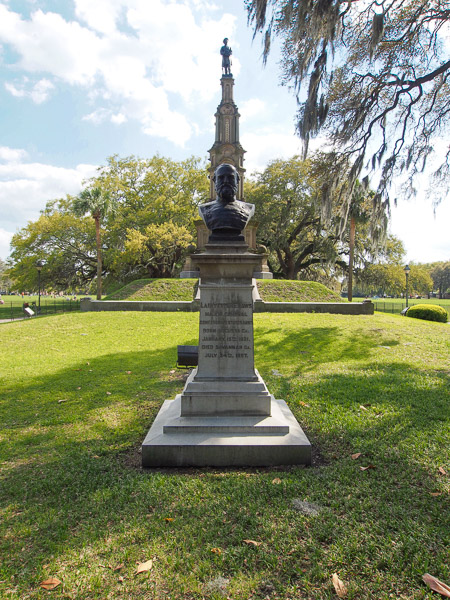
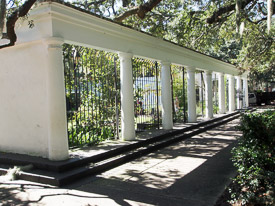
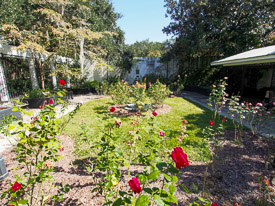
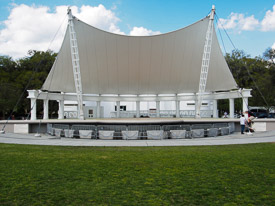
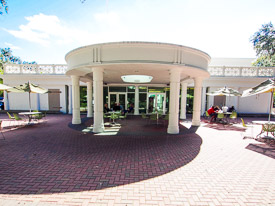
Franklin Square to Washington Square
(6 Squares)
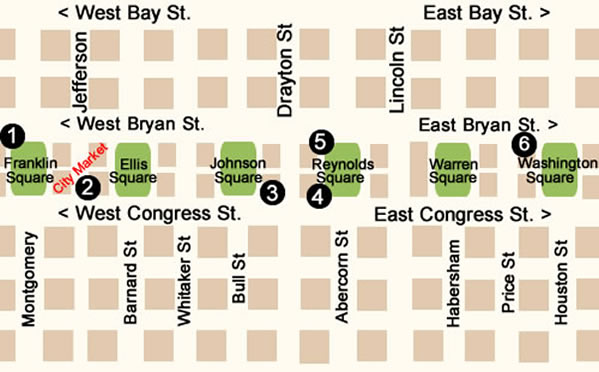
W. Bryan to E. Bryan Street (6 Squares)
Points of Interest:
Franklin Square
- Chasseurs-Volontaires de Saint-Domingue Monument - Center of Franklin Square
Ellis Square
- Johnny Mercer Sculpture
- Dancing Fountains
Johnson Square *****
- Nathanael Greene Monument - Center of Johnson Square
Reynolds Square
- John Wesley Monument - Center of Reynolds Square
Warren Square
- George Basil Spencer House - 22 Habersham Street (near Warren Square)
Washington Square
Franklin Square
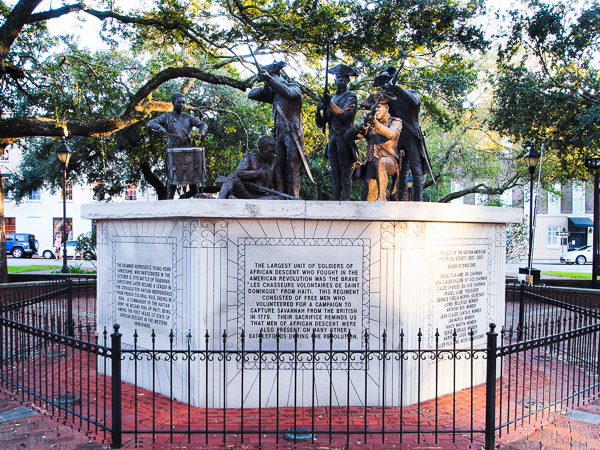 Chasseurs volontaires de Saint-Domingue Monument
Chasseurs volontaires de Saint-Domingue Monument
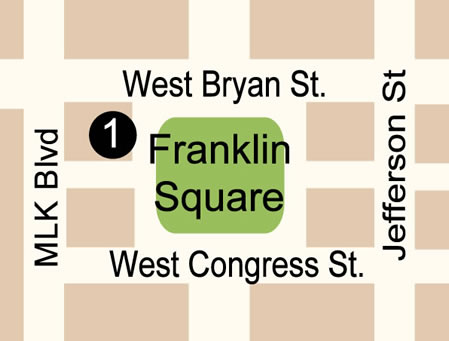
Points of Interest
 First African Baptist Church - 23 Montgomery Street
First African Baptist Church - 23 Montgomery Street
- Chasseurs-Volontaires de Saint-Domingue Monument - Center of Franklin Square
Franklin Square was established in 1790 along Montgomery Street between Congress Street and Bryan Street and was named after Benjamin Franklin.
On the west side of the square at 23 Montgomery Street is the First African Baptist Church, recognized as the oldest black Christian congregation in the country. The church was organized in 1788, 12 years before the first Baptist church for whites was built in Savannah.
Franklin Square was destroyed in 1935 when Montgomery Street became a federal route, but the square and much of the surrounding area were restored in the 1980s to commemorate the 250th anniversary of the founding of Georgia.
Ellis Square
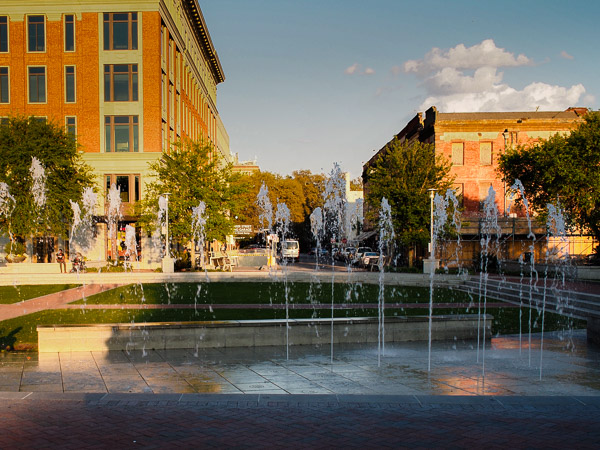
Water fountain for children to play
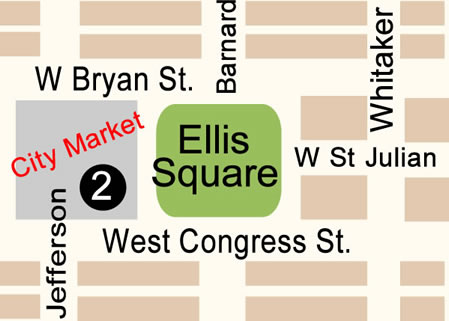
Points of Interest
- Johnny Mercer
- Dancing Fountains
Ellis Square , the city's second largest, was among the first four squares plotted by James Edward Oglethorpe in 1733. It was named for Sir Henry Ellis, Georgia's second royal governor. It is located on Barnard between Bryan and Congress Streets.
Since 1872, it was home to the City Market where farmers sold crops directly to shoppers. It was also known as Marketplace Square because it was the center of commerce from the 1730's through the 1950's. Prior to Union General Sherman's arrival in December 1864 it was also the site of a slave market.
In 1954 Ellis Square was demolished to make way for a new four-story parking garage. This loss motivated the citizens to organize Savannah's historic preservation movement and today Ellis Square has been resurrected. The city spent nearly $32 million and more than four years bringing back the 1.5-acre square.
The fountains in Ellis Square are probably the most modern in the Squares. Shooting water straight up into the air from underground, the jets of water dance around in random patterns. At night, the lights are turned on the fountain, making the jets of water colorful. Most nights the fountain is turned off at 10:00p.
On the west side of Ellis Square is a small sculpture of Johnny Mercer.
Johnson Square *****
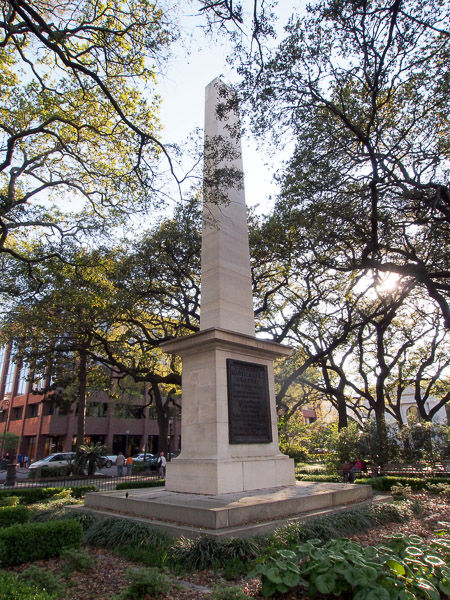
Monument to Maj. Gen. Nathanael Greene

Points of Interest
 Christ Church - 28 Bull Street
Christ Church - 28 Bull Street
- Nathanael Greene Monument - Center of Johnson Square
Johnson Square was laid out in 1733 and was the first of the original squares and is still the largest. Johnson Square is located on Bull, between Bryan and Congress Streets.
Johnson Square has two fountains and a sundial. The original sundial was replaced in 1933 and it still sits today on the south side of the square. You can also find a plaque and mosaic map of the early city in Johnson Square. There is also a white marble bench in Johnson Square which pays tribute to Johnny Mercer, Savannah's popular and successful songwriter.
Johnson Square contains a tall white obelisk memorializing the Revolutionary War hero Nathanael Greene. The cornerstone was laid in 1825. Greene, who was originally buried in the Colonial Park Cemetery, was re-interred under this monument in 1902.
On the east side of Johnson Square is the Christ Church (now known as Christ Episcopal Church), called the Mother Church of Georgia. This was the first church in historic Savannah.
Another landmark of Johnson Square includes the Johnson Square Business Center. This building, formerly known as the Savannah Bank Building, was the city's first "skyscraper", built in 1911. Johnson square is known as the financial district, or banking square, and many of the City's financial services companies are located here
Reynolds Square
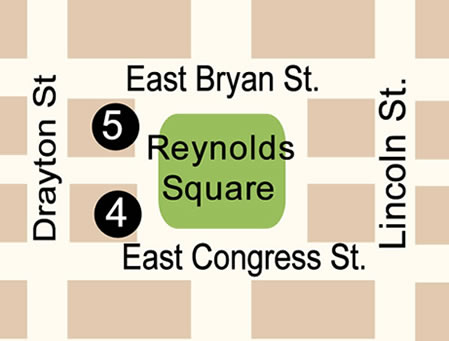
Points of Interest
 Pink House - 23 Abercorn Street
Pink House - 23 Abercorn Street
 Oliver Strugis House - 27 Abercorn Street
Oliver Strugis House - 27 Abercorn Street
- John Wesley Monument - Center of Reynolds Square
Reynolds Square was laid out in 1734 and was named for Capt. John Reynolds, governor of Georgia in the mid-1750's. A bronze statue honoring John Wesley, founder of Methodism stands in the center of the square. It is located on Abercorn, between Bryan and Congress Streets.
Also found on Reynolds Square is the Lucas Theater, located at 22 Abercorn Street. This theater was built in 1921 and was originally designed for silent films and vaudeville and was eventually refitted for talkies. It was about to be demolished until a public-private partnership was formed to modernize and restore it.
Warren Square
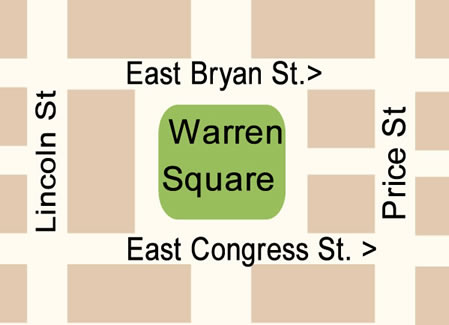
Points of Interest
- George Basil Spencer House - 22 Habersham Street (near Warren Square)
Warren Square was laid out after the final departure of James Oglethorpe and after the American Revolution in 1790. This square was named for General Joseph Warren, a Revolutionary War hero who was killed at the Battle of Bunker Hill. Warren Square is located on Habersham, between Bryan and Congress Streets. There are a number of historical homes near Warren Square. Many homes which were threaten with demolition were brought to Warren Square.
At 22 Habersham Street near Warren Square, George Basil Spencer had a post-colonial home built sometime after 1790 and before 1804. This was one of the most elaborate houses of its day.
Washington Square
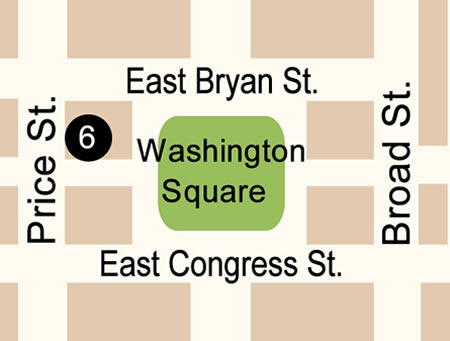
Points of Interest
 Hampton Lillibridge House - 507 East Saint Julian Street
Hampton Lillibridge House - 507 East Saint Julian Street
Washington Square was one of several new squares that came along in a quick succession after the American Revolution. Built in 1790, Washington Square was named in 1791 for the first President of the United States. Washington Square is located on Houston, between Bryan and Congress Streets.
There are a number of interesting homes in this area. Almost every home on Washington Square and the immediately surrounding streets has been owned by a person or family of historical interest or has some unique attribute, such as having been moved from another location or rebuilt in the late 1900s in order to preserve it.
History of the Savannah Squares
In 1733 four open squares were laid out in Savannah by General James Edward Oglethorpe creating America's first pre-planned city. Additional squares were added during the 18th and 19th centuries, and by 1851 there were 24 squares. In the 20th century, three of the squares were demolished or altered beyond recognition, leaving 21. In 2010, one of the three "lost" squares, Ellis, was reclaimed.
Each square measures approximately 200 feet from east to west, but the squares vary north to south from approximately 100 to 300 feet. Traffic flows one-way which is counterclockwise around the squares.
The five squares along Bull Street — Monterey, Madison Chippewa, Wright and Johnson — were intended to be grand monument spaces and have been called Savannah's "Crown Jewels" (see Day 1 on Itineraries. Many of the other squares were designed more simply as parks, although most serve as memorials as well.
Architect John Massengale has called Savannah's city plan "the most intelligent grid in America, perhaps the world", and Edmund Bacon wrote that "it remains as one of the finest diagrams for city organization and growth in existence."
Note: Savannah originally had 24 squares but Elbert Square and Liberty Square were lost in the 1930's.
Elbert Square
Elbert Square was laid out in 1801 and named for Samuel Elbert, a Revolutionary soldier, sheriff of Chatham County, and Governor of Georgia. It was located on Montgomery between Hull and Perry streets. After the Great Fire of 1820 many of the original buildings were sold in order to install water cisterns. In the 1930's it was paved over to make way for improvements to Montgomery Street and today is represented by a small grassy area across Montgomery from the west entrance to the Civic Center
Liberty Square
Liberty Square was laid out in 1799 and named in honor of the Sons of Liberty and the victory over the British in the Revolutionary War. It was located on Montgomery between State and York Streets. In the 1930s, US 17 was built through the middle of this square and Elbert Square. As a result, each square was reduced to a small strip of land. What remains of Liberty Square sits right across the street from the Chatham County Courthouse and Jail. It is the site of the " Flame of Freedom" sculpture.
Orleans Square to Crawford Square (3 Squares)
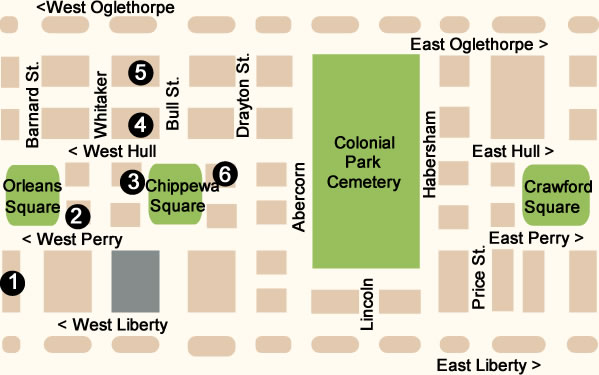
W. Hull and E. Hull Street (3 Squares)
Points of Interest:
Orleans Square
 Savannah Civic Center
Savannah Civic Center
- German Societies Fountain - Center of Orleans Square
Chippewa Square *****
 Independent Presbyterian Church
Independent Presbyterian Church
Tours on Friday 9:00a - 1:00p
- Statue of James Oglethorpe - Center of Chippewa Square
Colonial Park Cemetery
- Served as Savannah’s primary public cemetery from 1750 to 1853.
Crawford Square
- White Gazebo - center of Crawford Square
- Old County Jail and Police Department built in 1887 - (Near Crawford Square)
Orleans Square
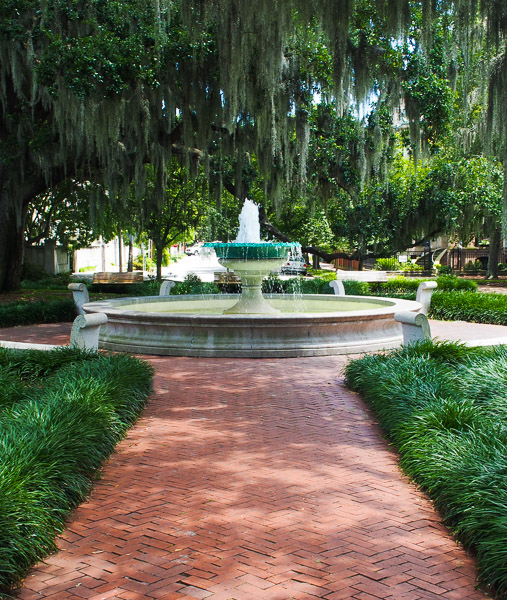 German Societies Fountain
German Societies Fountain 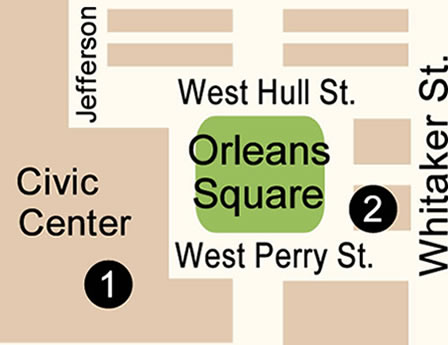
Points of Interest
 Savannah Civic Center
Savannah Civic Center
- German Societies Fountain - Center of Orleans Square
Orleans Square was laid out in 1815 and commemorates General Andrew Jackson's victory in the Battle of New Orleans. Orleans Square is located on Barnard, between Hull and Perry Streets, and is adjacent to the Savannah Civic Center.
The German Memorial Fountain stands in the center of the square. It honors the German immigrants who came to Savannah. There are several buildings designed and built by prominent architects and builders between 1800 and 1875 that are located around Orleans Square.
Chippewa Square

Monument to James Oglethorpe 
Points of Interest
 Independent Presbyterian Church
Independent Presbyterian Church
- Statue of James Oglethorpe - Center of Chippewa Square
Chippewa Square was laid out in 1815, after the Revolution, and was named in honor of American soldiers killed in the Battle of Chippewa during the War of 1812.
Chippewa Square is one of Savannah’s most popular Squares. In the middle of the Square is the monument to the founder of Savannah, James Edward Oglethorpe which was placed in the square in 1910.
Chippewa Square is intersected by Hull, McDonough and Perry Streets, with Liberty Street running the southern boundary of the ward.
Buildings of interest surrounding the square are the First Baptist Church, built between 1831 and 1833 and the Philbrick-Eastman House built in 1844. The First Baptist Church is the oldest house of worship in Savannah. The Independent Presbyterian Church, built in 1891, is located on the northwest corner of the square. Also, located on Chippewa Square is the Savannah Theatre. This theatre, built in 1818, is the oldest continually running theatre in the United States.
Colonial Park Cemetery
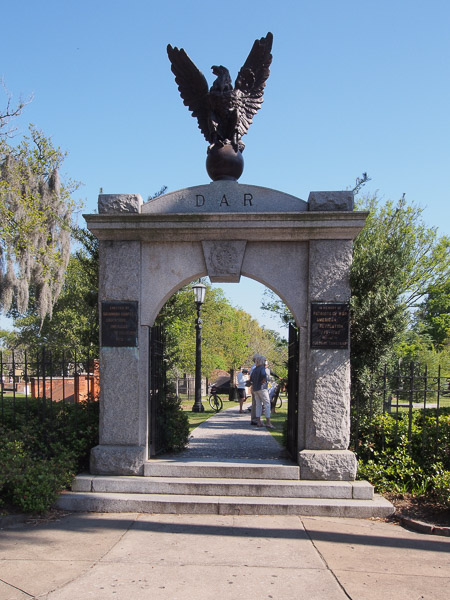
Colonial Cemetery
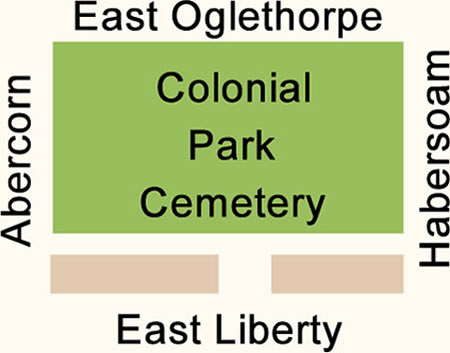
Opened to the public
November - March 8:00a - 5:00p
March - November 8:00a - 8:00p
201 Abercorn Street
Colonial Park Cemetery is located in the heart of Savannah's Historic District and served as Savannah’s primary public cemetery from 1750 to 1853. It was established in 1750 and by 1789 had expanded by 300 percent to the current size of six acres. Among those buried here are Button Gwinnett, a signer of the Declaration of Independence. This cemetery is a popular stop for local ghost tours, including one walking tour that goes right through the cemetery at night.
More than 700 victims of the 1820 Yellow Fever epidemic are buried in Colonial Park Cemetery. There are also many victims of Savannah's tragic dueling era.
The cemetery was already closed to burials before the start of the Civil War and no Confederate soldiers are buried there. But the war did leave its mark on the cemetery. Federal troops took over the cemetery grounds during their occupation of Savannah and many of the graves were looted and desecrated. It has been said that Union soldiers changed the dates on many of the headstones.
The Colonial Park Cemetery is also home to one of Savannah's most famous ghosts, that of "Rene Asche Rondolier (or Renee Rondolia Asch), a disfigured orphan who was said to have called Colonial Park his home in the early 1800s. Accused of murdering two girls whose bodies were found in the cemetery, Rene was dragged to the nearby swamps and lynched and left for dead. More dead bodies turned up in the cemetery in the days that followed. The townspeople were convinced it was Rene's ghost and some still call the cemetery, Rene's playground.
The park-like cemetery is the oldest intact municipal cemetery in Savannah. It has been closed to interments since 1853. The cemetery became a city park in 1896.
Crawford Square
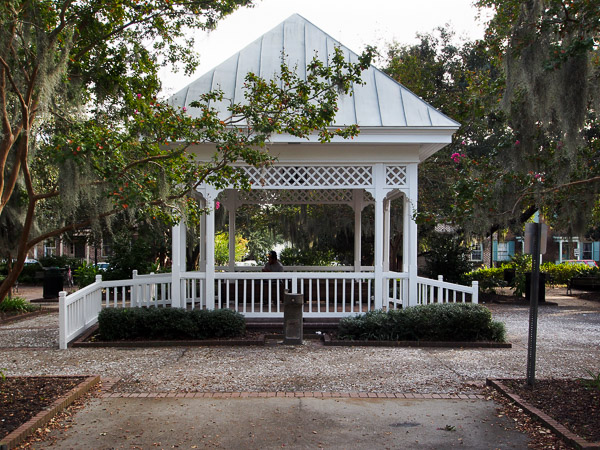
White Gazebo in Crawford Square
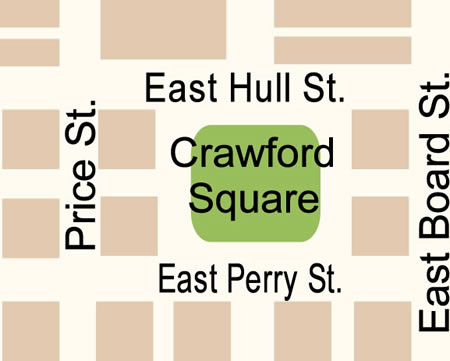
Points of Interest
- White Gazebo - center of Crawford Square
- Old County Jail and Police Department built in 1887 - (Near Crawford Square)
Crawford Square was laid out in 1841 and named in honor of Secretary of the Treasury William Harris Crawford. It is located on Houston, between Hull and Perry Streets on the eastern edge of the historic district. During the era of Jim Crow this was the only square in which African-Americans were permitted. In the early years all of the Savannah squares were fenced in but Crawford Square is the only one that remains fenced. Part of the original fence remains on the square. The square contains playground facilities, a basketball court, and a gazebo and is one of the smallest squares.
Crawford Square and its ward are home to several important buildings and sites, including the county jail and police department, as well as the police barracks. The jail and police department was housed in an 1887 building located at 235 Habersham Street The building is Italianate in style with a mosque-like dome reminiscent of north African and Egyptian architecture. The police barracks, which sits on the border of the Colonial Cemetery, date to approximately 1870 and is also an Italianate style. These buildings are now owned by SCAD (Savannah College of Art and Design).
Pulaski Square to Troup Square (4 Squares)
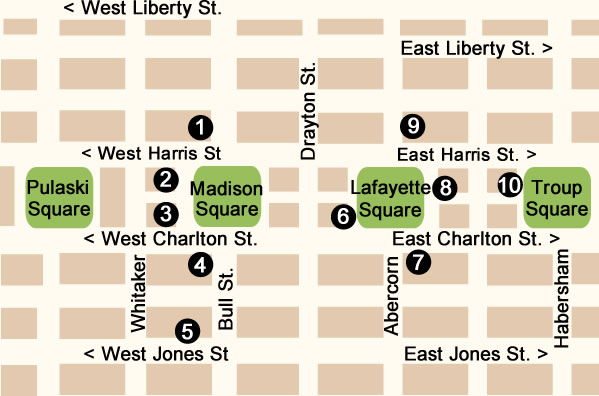
W. Harris and E. Harris Street (4 Squares):
Points of Interest:
Pulaski Square
- Interesting homes and restore gardens
Madison Square *****
 Sorrel Weed House - Open to the public for tours
Sorrel Weed House - Open to the public for tours
 Green Meldrin House
Green Meldrin House
Hours: Tuesday, Thursday & Friday 10:00a - 4:00p
Saturday 10:00a - 1:00p
Tours last 30 min
- Gryphon Tea Room - 337 Bull Street
- Monument to Sgt William Jasper - Center of Madison Square
Lafayette Square
 Andrew Low House
Andrew Low House
Tours: Monday - Saturday 10:00a - 4:00p
Sunday 12:00p - 4:00p.
 Flannery O'Connor Childhood Home
Flannery O'Connor Childhood Home
Hours: Friday - Wednesday 1:00p - 4:00p
 Hamilton-Turner House - (currently a Bed & Breakfast)
Hamilton-Turner House - (currently a Bed & Breakfast)
 Cathedral of St. John Baptist
Cathedral of St. John Baptist
Hours: open to the public Monday - Saturday 9:00a to 5:00p
- Semiquincentenary Fountain - Center of Layafette Square
Troup Square
- Armillary sphere - Center of Troup Square
Pulaski Square
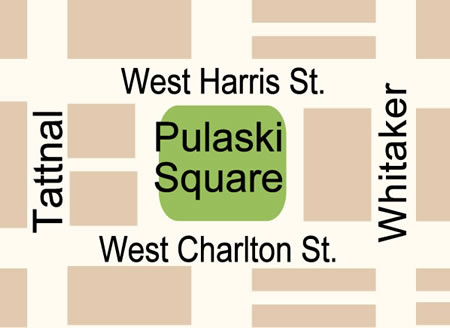
Points of Interest
- Interesting homes and restore gardens
Pulaski Square was laid out in 1837 and is named for General Casimir Pulaski, a Polish-born Revolutionary War hero who died of wounds received in the Siege of Savannah in 1779. Pulaski square is located on Barnard, between Harris and Charlton Streets and is known for its live oaks.
The neighborhood around Pulaski Square has many interesting homes. Many are paired houses, row houses, center hall floor plans and five bay houses. Italianate, Greek revival style was extensively used when designing these homes. They are mostly two to four stories in height and behind the brick walls are beautifully restored gardens.
Madison Square *****
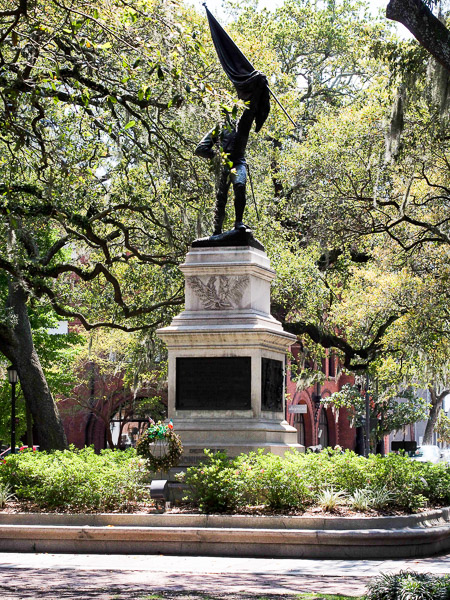
Monument to Sgt. William Jasper
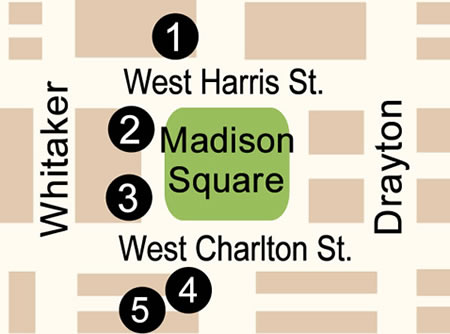
Points of Interest
 Sorrel Weed House - Open to the public for tours
Sorrel Weed House - Open to the public for tours
 Green Meldrin House
Green Meldrin House
Tours: Tuesday, Thursday & Friday 10:00a - 4:00p
Saturday 10:00a - 1:00p
Tours last 30 min
- Gryphon Tea Room - 337 Bull Street
- Monument to Sgt William Jasper - Center of Madison Square
Madison Square was named after the fourth President of the United States, James Madison. The square was laid out in 1837 and commemorates Sgt. William Jasper who fought in the Revolutionary War. In the center of the square is an 1888 statue of Sgt. William Jasper, a soldier in the Siege of Savannah who, though mortally wounded, heroically recovered his company's banner.
Madison Square also features vintage cannons from the Savannah Armory. These cannons mark the starting points of the first highways in Georgia, the Ogeechee Road leading to Darien and the Augusta Road to Augusta.
On the west side of Madison Square is St John's Episcopal Church which was built in 1853. Next door to the church is the Green-Meldrim House which was also completed in 1853. The Green-Meldrim House has beautiful iron work and unique features. On the south side is the Sorrel - Weed house built in 1841. On the southwest corner of Madison Square stands the Masonic Temple.
Lafayette Square

Points of Interest
 Andrew Low House
Andrew Low House
Tours: Monday - Saturday 10:00a - 4:00p
Sunday 12:00p - 4:00p.
 Flannery O'Connor Childhood Home
Flannery O'Connor Childhood Home
Hours: Friday - Wednesday 1:00p - 4:00p
 Hamilton-Turner House - (currently a Bed & Breakfast)
Hamilton-Turner House - (currently a Bed & Breakfast)
 Cathedral of St. John Baptist
Cathedral of St. John Baptist
Hours: open to the public 9:00a to 5:00p Monday - Saturday
Lafayette Square is located on Abercorn, between Harris and Charlton Streets, was laid out in 1837. The square contains a fountain commemorating the 250th anniversary of the founding of the Georgia colony.
On the Northwest corner of Abercorn and Charlton Streets is the elegant Andrew Low House built in 1849. On the south side of Charlton Street is an unusual West Indies-style home built in 1852. It was designed to have the main house entered from the piazza.
The three-bay side hall townhouse in the Greek revival style at 207 East Charlton was the childhood home of prize-winning author Flannery O’Connor.<
The Cathedral of St. John Baptist located at Abercorn and Harris is the oldest Roman Catholic Church in Georgia. Rebuilt from the original design following a tragic fire in 1898, the church’s Gothic revival spires can be seen throughout the city.
Troup Square
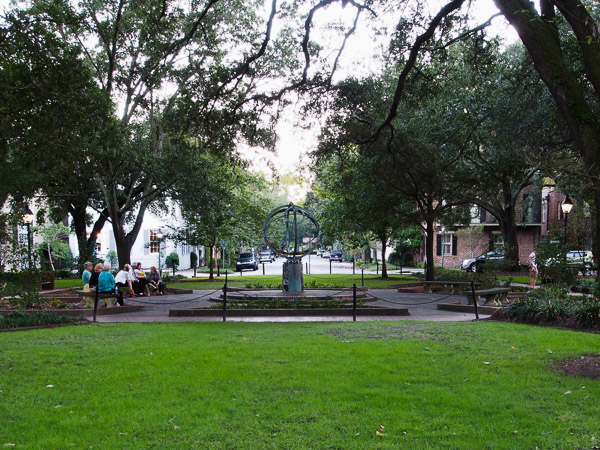
Armillary Sphere at Troup Square
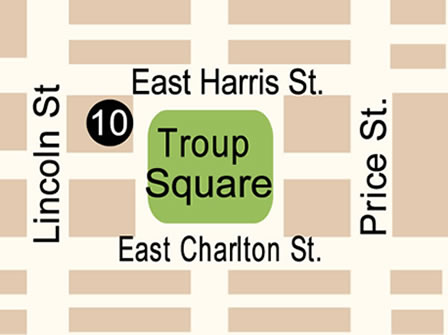
Points of Interest
- Armillary sphere - Center of Troup Square
Troup Square was laid out in 1851, and named for George Michael Troup, congressman, senator and Governor of Georgia from 1823-1827. It is one of the smaller squares. This square features a bronze 1870s era Victorian armillary mounted on six bronze turtles. On the west side of the square is a special dog fountain for canine use.
The Unitarian Universalist Church built in 1851 sits on the west side of Troup Square at 321 Habersham.
Many of the row houses around the square were built after 1870 due to the interruption of the Civil War.
Telfair Square to Greene Square (5 Squares)
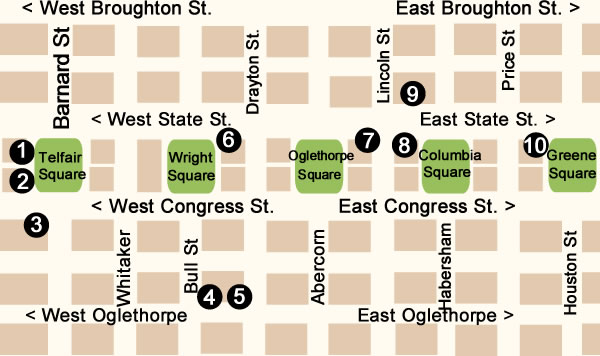
W. State and E. State Street (5 Squares):
Points of Interest:
Telfair Square
Wright Square *****
 Juliette Gordon Low Birthplace
Juliette Gordon Low Birthplace
 Ballastone Inn (Bed & Breakfast)
Ballastone Inn (Bed & Breakfast)
- Gordon Monument - Center of Wright Square
- Tomochichi Monument - Bull Street, Between West State and West York Streets on Wright Square
Oglethorpe Square
Columbia Square
- Wormsloe Fountain - Center of Columbia Square
Greene Square
Telfair Square
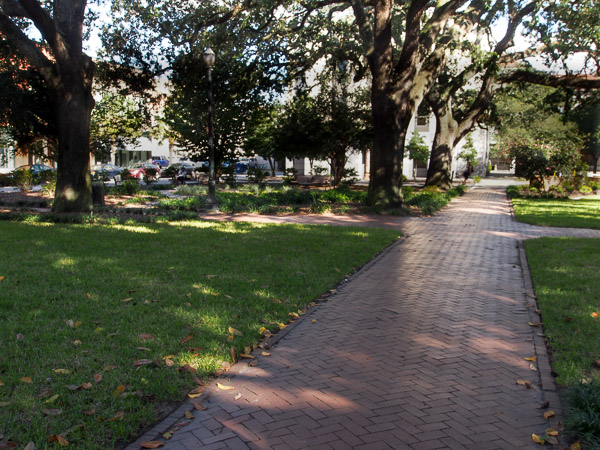
Telfair Square
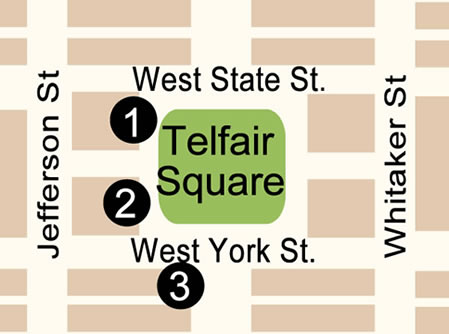
Points of Interest
Telfair Square was the last of four squares that was laid out in 1733, before James Oglethorpe returned to England for a visit. This square was name in honor of the Telfair family and their contributions to early Savannah history and culture. Telfair Square is located on Barnard, between State and York Streets.
Mary Telfairs’ brother, Alexander, built one of the beautiful and notable mansions at 121 Barnard Street. This home was deeded to the city upon her death and opened as the Telfair Museum of Arts and Sciences in 1886.
The historic Trinity Methodist Church is located at 127 Barnard on Telfair Square. This Greek Revival style church was built in 1848.
Wright Square *****
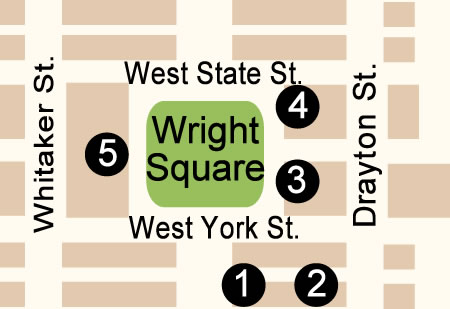
Points of Interest
 Juliette Gordon Low Birthplace
Juliette Gordon Low Birthplace
 Ballastone Inn (Bed & Breakfast)
Ballastone Inn (Bed & Breakfast)
- Gordon Monument - Center of Wright Square
- Tomochichi Monument - Bull Street, Between West State and West York Streets on Wright Square
- U.S. Courthouse
Wright Square is one of the original 4 Squares to be laid in 1733 by General Oglethorpe. Wright Square is located on Bull, between State and York Streets.
A courthouse has stood on this square since the time of Oglethorpe. Monthly auctions of livestock, government bonds, furniture and other goods were held in Wright Square.
Wright Square was the location of the Gallows in Colonial Savannah. The hangings which took place in Wright Square were public hangings. The first jail in historic Savannah was at the north end of Wright Square in the 1700's and 1800's. If any of the prisoners were sentenced to death they were sent to the gallows in Wright Square. After they were hung their bodies were simply buried right behind the gallows. Today, there is a CVS on the site of the jail and the Courthouse stands where the gallows once stood. The post office also stands on the square. It is located on the west side and was constructed in 1898. The current courthouse was built in 1889.
The Lutheran Church of the Ascension is located on the northeast trust lot. This is one of Savannah’s most loved churches and landmarks. It was built in the Norman and Gothic styles and has one of Savannah’s most dramatic church interiors.
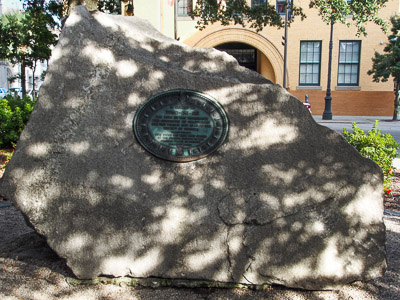 Originally, the grave site of Chief Tomo-Chi-Chi, the Yamacraw chief who offered peace and cooperation with the settlers, occupied the center of Wright Square after his death in 1739. More than 100 years later, after William W. Gordon brought immense wealth to Savannah by constructing a railroad which brought cotton to the docks and wharves of Savannah from distant plantations, the Savanahians felt that he should be honored by a memorial in Wright Square. Therefore, they removed Tomo-Chi-Chi’s grave and replaced it with a monument to Gordon, which is there today.
Originally, the grave site of Chief Tomo-Chi-Chi, the Yamacraw chief who offered peace and cooperation with the settlers, occupied the center of Wright Square after his death in 1739. More than 100 years later, after William W. Gordon brought immense wealth to Savannah by constructing a railroad which brought cotton to the docks and wharves of Savannah from distant plantations, the Savanahians felt that he should be honored by a memorial in Wright Square. Therefore, they removed Tomo-Chi-Chi’s grave and replaced it with a monument to Gordon, which is there today.
Gordon's widow objected strongly to this perceived insult to Tomochichi. She and other members of the Colonial Dames of the State of Georgia planned to erect a new monument to Tomochichi. A massive piece of granite from Stone Mountain, purchased and planned by William Gordon’s widow and other members of the Colonial Dames of Georgia, was erected in 1899 to honor Tomochichi. Tomochichi was laid to rest on the southeast side of Wright Square.
Oglethorpe Square

Points of Interest
Oglethorpe Square was laid out in 1742 and was named in honor of Georgia founder General James Oglethorpe. At the northeast of the square is Owens-Thomas House. It is considered, both in its day and today, Savannah’s most sophisticated house.
The Presidents' Quarters Inn, a 16-room historic bed and breakfast, is located on the southeast side. Oglethorpe Square is located on Abercorn, between State and York Streets; President Street intersects east and west.
Oglethorpe Square was the final square of the six that James Oglethorpe laid out during the time that he resided in the colony
Columbia Square
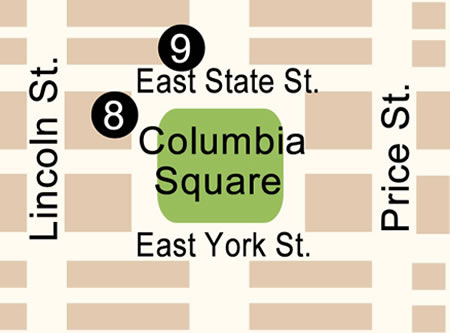
Points of Interest
- Wormsloe Fountain - Center of Columbia Square
Columbia Square was laid out in 1799 and is named for Columbia, the poetic personification of the United States. It is located on Habersham, between State and York Streets. In the center of the square is a lovely cast iron fountain imported from the Wormsloe Plantation,the estate of Noble Jones, one of Georgia's first settlers. The fountain is decorated with vines, leaves, flowers, and other woodland motifs.
Columbia Square is a lovely square shaded by four giant live oaks. Nearby is the Davenport House, built in 1812, Victorian Mansion and The Kehoe House which was built in 1892.
Greene Square

Points of Interest
Greene Square was laid out in 1799 and is named for Revolutionary War hero General Nathanael Greene who fought the English in the south during the Revolution. The square is located on Houston, between State and York Streets.
The church located at 123 Houston Street was built in 1925 for the Second African Baptist Church. It replaced an earlier church structure which had been built in 1802, the year the church was formed by Andrew Bryan. Also on the square is the Green Palm Inn built in 1897. It is now a bed & breakfast.
